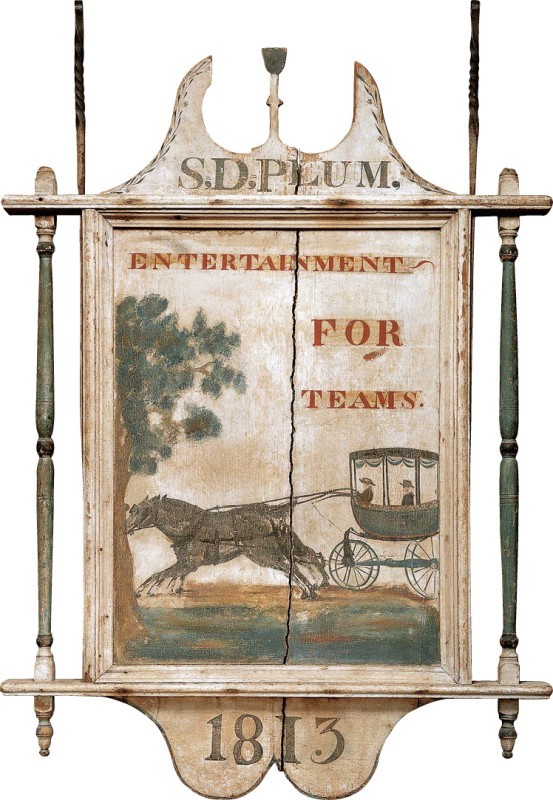
S. D. Plum tavern sign (double-sided, recto), probably Meriden, Connecticut, 1813. Paint on pine with iron. H. 51", W. 34", D. 3". (Courtesy, American Folk Art Museum, gift
of Ralph Esmerian, acc. 2013.1.55; photo, 2000 John Bigelow Taylor; Art Resource, New York.)
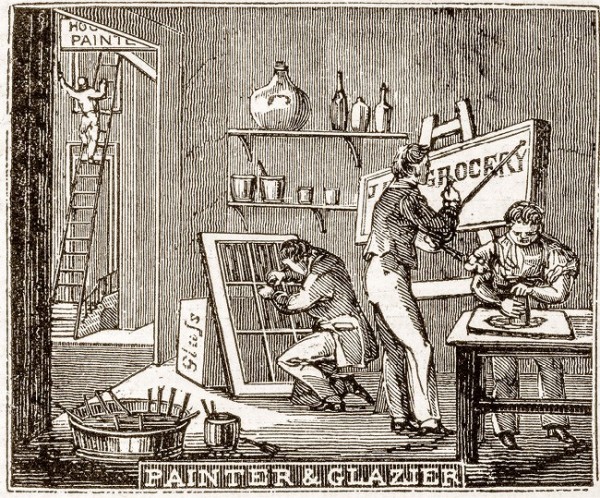
Shop of the Painter and Glazier, in Edward Hazen, The Panorama of Professions and Trades (Philadelphia: U. Hunt, 1839), p. 215. (Courtesy, Winterthur Library, Printed Book
and Periodical Collection.)
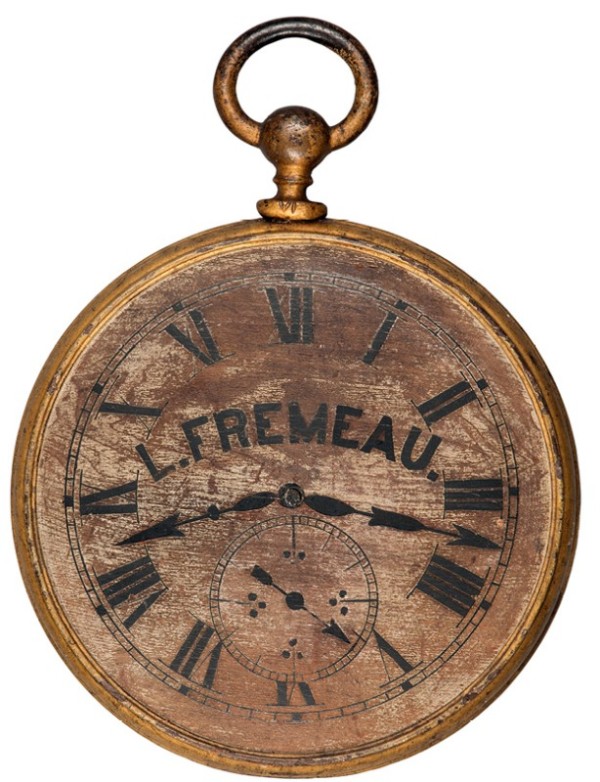
Jeweler’s trade sign, Louis Fremeau, Burlington, Vermont, nineteenth century. Carved and painted wood. H. 22", Diam. 15". (Courtesy, Collection of Shelburne Museum, gift of Mrs. Louis Fremeau, acc. 1958-5.2; photo, Andy Duback.)
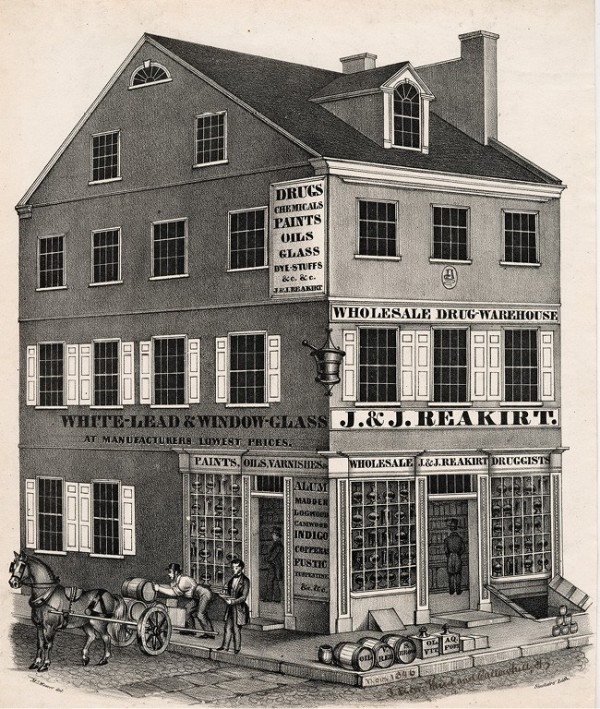
Drug and paint store, J. & J. Reakirt, Philadelphia, Pennsylvania, ca. 1844. Lithograph drawn by Mathias S. Weaver, printed by Thomas Sinclair. H. 16", W. 13". (Courtesy, The Library Company of Philadelphia.) The building exhibits several types of signs: informational boards fixedflat against the external structure, information painted directly on an exterior surface, and a three-dimensional mortar and pestle suspended at the second-story level at a corner of the building.
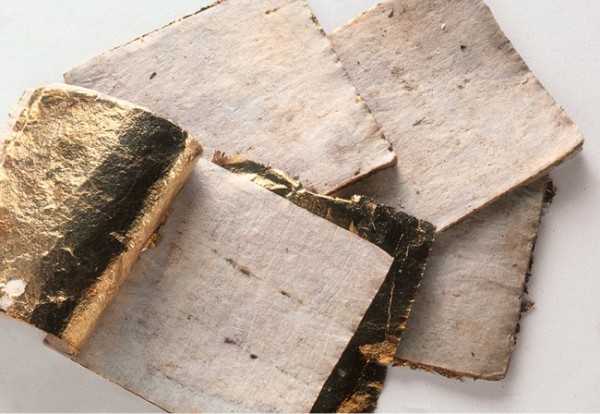
Books of gold leaf, probably England, 1800–1830. Gold leaf interfaced with laid paper. H. 3 9/16", W. 3 13/16" (closed booklet). (Courtesy, Monmouth County Historical Association, Freehold, New Jersey; photo, Winterthur Museum.)

Detail of a delegation of Native Americans to Philadelphia, New Lutheran Church, in Fourth Street Philadelphia, drawn, engraved, and colored by William Russell Birch (1755–1844) and Thomas Birch (1779–1851), published in The City of Philadelphia . . . as It Appeared in the Year 1800 [hereafter Birch’s Views of Philadelphia] (Philadelphia: W. Birch and Son, 1800), plate 6. (Courtesy, Winterthur Library, Printed Book and Periodical Collection.) The scene describes a method of hanging shop signs above the walkways of the city. The male figure with an outstretched arm at the right front is said to be Frederick Augustus Muhlenberg, speaker of the U.S. House of Representatives.
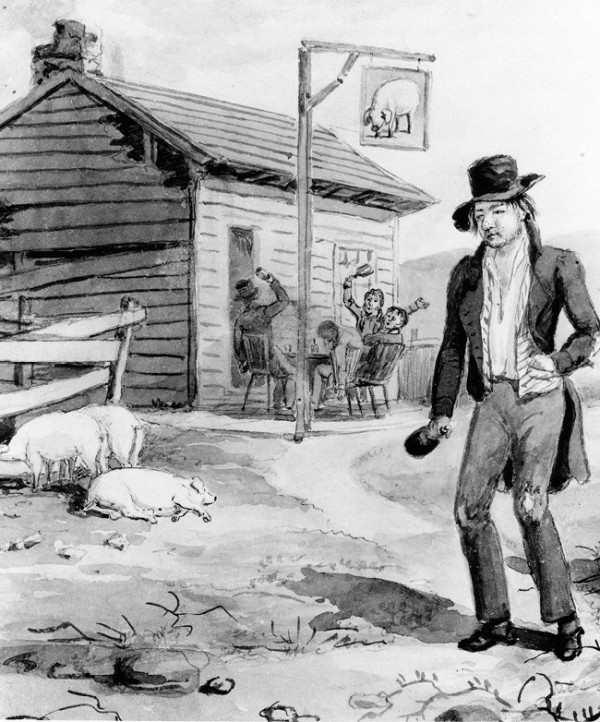
Detail of Virtue and Vice, Sobriety and Drunkenness, Thomas Birch, Philadelphia, ca. 1830. Ink and watercolor on paper. H. 10 1/16", W. 14 7/16". (Courtesy, Winterthur Museum,
acc. 67.0131.)
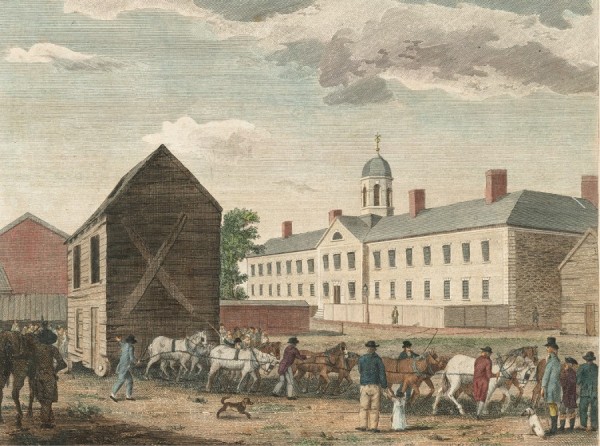
Moving a building in Philadelphia, Goal, in Walnut Street Philadelphia, drawn, engraved, and colored by William Russell Birch and Thomas Birch, published in Birch’s Views of Philadelphia, plate 24. (Courtesy, Winterthur Library, Printed Book and Periodical Collection.)
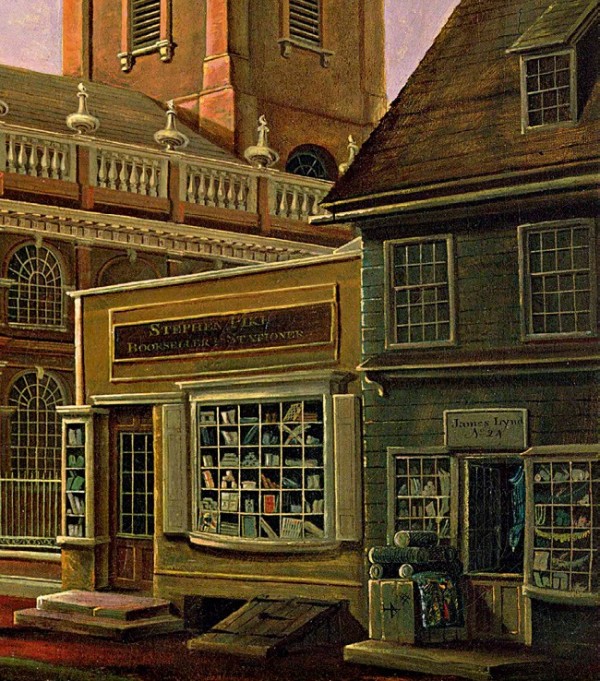
Detail of shop facades adjacent to Christ Church, Philadelphia, from Christ Church, 1811, by William Strickland (1787–1854), Philadelphia, Pennsylvania, 1811. Oil on canvas. Overall H. 48", W. 52". (Courtesy, Historical Society of Pennsylvania Collection, Bridgeman Images.) The shop facades detail a show box next to the shop door at the left and interior display shelves at transom levels in the bow window and the windows of the adjacent building at the right.
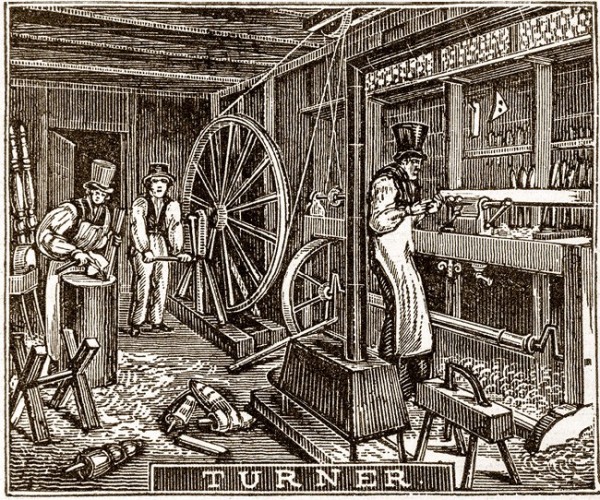
Shop of the Turner, in Edward Hazen, The Panorama of Professions and Trades (Philadelphia: U. Hunt, 1839), p. 219. (Courtesy, Winterthur Library, Printed Book and Periodical Collection.)

Shop of the Hatter, in Edward Hazen, The Panorama of Professions and Trades (Philadelphia: U. Hunt, 1839), p. 52. (Courtesy, Winterthur Library, Printed Book and Periodical Collection.)
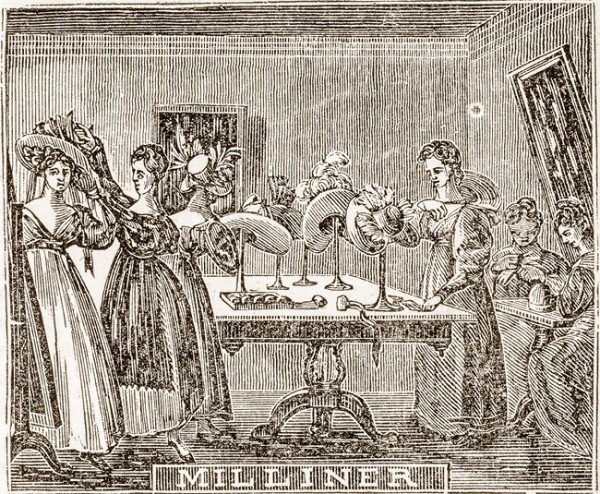
Shop of the Milliner, in Edward Hazen, The Panorama of Professions and Trades (Philadelphia: U. Hunt, 1839), p. 61. (Courtesy, Winterthur Library, Printed Book and Periodical Collection.)
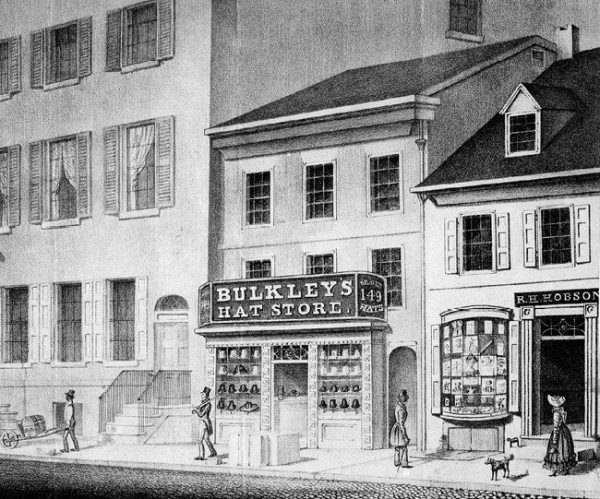
Detail of the Hat Store of C. and J. H. Bulkley, Philadelphia, Pennsylvania, ca. 1833. Lithograph printed by Childs and Inman. H. 7 1/2", W. 10 1/2". (Courtesy, The Library Company of Philadelphia.) The right-side return of the sign reads “BEAVER HATS.”
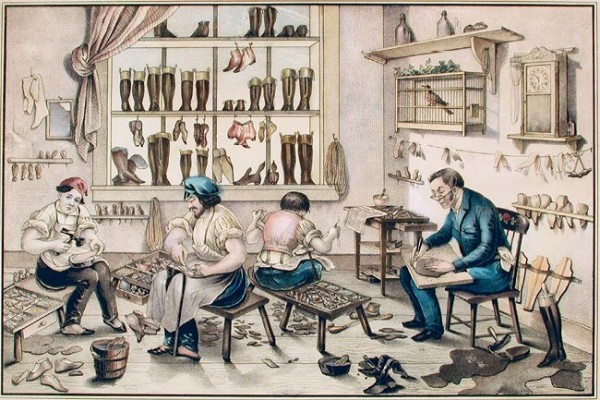
The Shoemakers, New York, ca. 1855. Chromolithograph printed by E. B. and E. C. Kellogg. H. 8 1/2", W. 12 1/2". (Courtesy, Connecticut Historical Society, acc. 1982.7.8.)

Lewis Miller (1796–1882), Jacob Nell, Barber, Shaving Nicklas Huber, York, Pennsylvania, ca. 1815–1825. Small ink and watercolor drawing and text on paper. (Courtesy, York County History Center, York, Pa.)
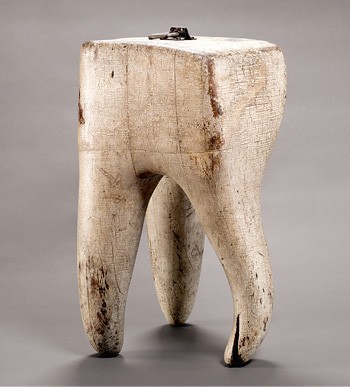
Dental trade sign of large tooth, date unknown. Carved and painted wood. H. 23 3/4", W. 12 1/2", D. 13 1/2". (Courtesy, Collection of Shelburne Museum, gift of Julius Jarvis, acc. 1962-181.)
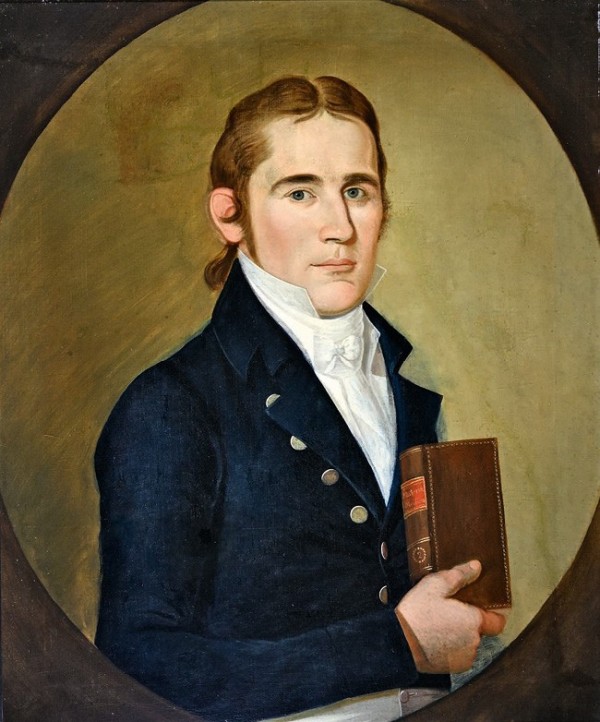
William Jennys (1774–1858), Portrait of Dr. John Brickett [1774–1848], Newburyport, Massachusetts, ca. 1805–1807. Oil on canvas. H. 29 1/2", W. 25". (Courtesy, Collections of the Museum of Old Newbury.) Dr. Brickett also was an apothecary and is portrayed holding a leather-bound volume of Materia Medica.
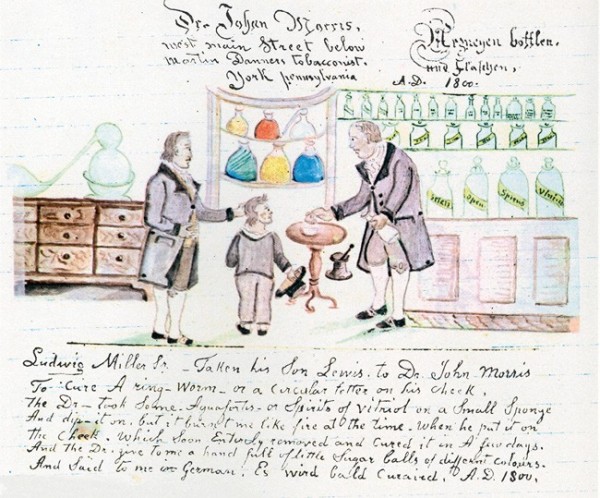
Lewis Miller, Office of Dr. Johan [John] Morris, York, Pennsylvania, 1800. Ink and watercolor drawing and text on paper. (Courtesy, York County History Center, York, Pa.) Pictured are Dr. Morris, Lewis Miller Sr., and his young son Lewis, later the chronicler of York.
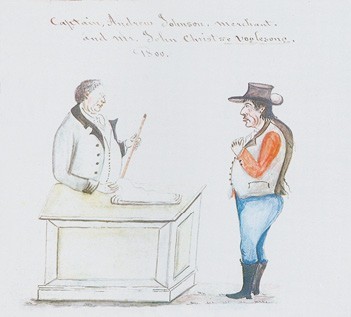
Lewis Miller, Store of Captain Andrew Johnson, Merchant, York, Pennsylvania, 1800. Ink and watercolor drawing and text on paper. (Courtesy, York County History Center, York, Pa.)
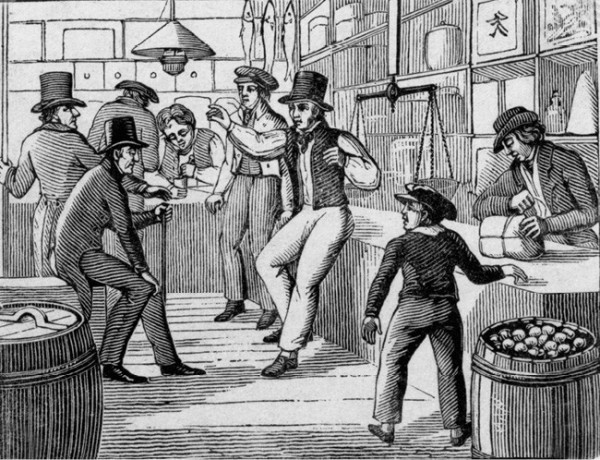
Alexander Anderson (1775–1870), [A Rural Grocery Store], northeastern United States, ca. 1825–1850. Wood engraving. (Courtesy, The Miriam and Ira D. Wallach Division of Art, Prints, and Photographs: Print Collection, “Scenes of daily life in nineteenth-century America,” The New York Public Library Digital Collections, 1794–1870.)

Shop of the Tailor, in Edward Hazen, The Panorama of Professions and Trades (Philadelphia: U. Hunt, 1839), p. 59. (Courtesy, Winterthur Library, Printed Book and Periodical Collection.) The owner of the shop or a clerk is using a desk at the extreme left.
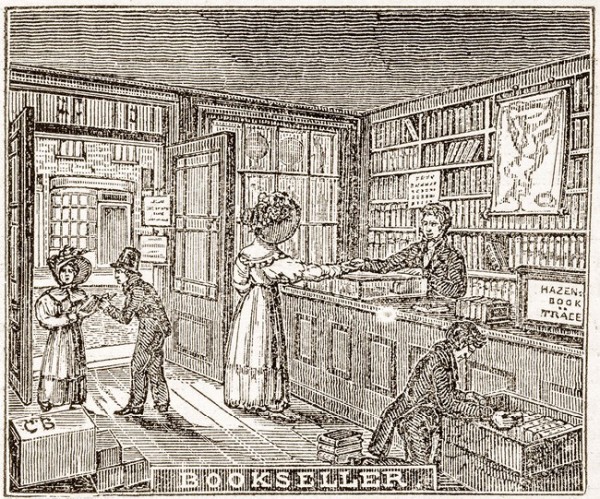
Shop of the Bookseller, in Edward Hazen, The Panorama of Professions and Trades (Philadelphia: U. Hunt, 1839), p. 195. (Courtesy, Winterthur Library, Printed Book and Periodical Collection.)
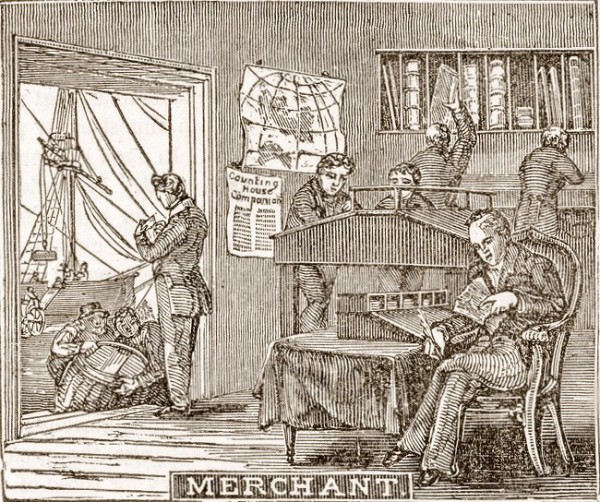
Counting House of the Merchant, in Edward Hazen, The Panorama of Professions and Trades (Philadelphia: U. Hunt, 1839), p. 109. (Courtesy, Winterthur Library, Printed Book and Periodical Collection.) The double-sided slant-top desk on tall legs was of a size to accommodate up to four clerks. A small portable desk with slanted writing surface and pigeonholes on the table below was available for additional use. The large case mounted on the wall held ledgers and other account books for easy reference at a counter along the wall.
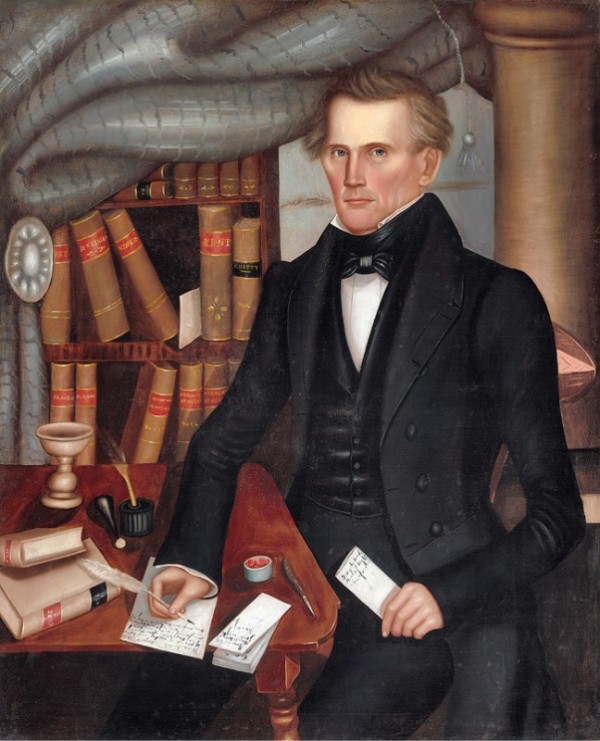
Horace Bundy (1814–1883), Vermont Lawyer, Manchester, Vermont, 1841. Oil on canvas. H. 44", W. 35 1/2". (Courtesy, National Gallery of Art, acc. 1953.5.4.) The anonymous lawyer’s law books are handy in the bookcase behind him. His writing equipment is at hand: a sharpened quill pen, an inkpot with an additional quill pen, a tall cup-shaped sander containing blotting sand to dry his writing, a small pot containing red sealing wax, and a personal seal with a bulbous handle, the seal at the opposite end containing the lawyer’s initials or a device.
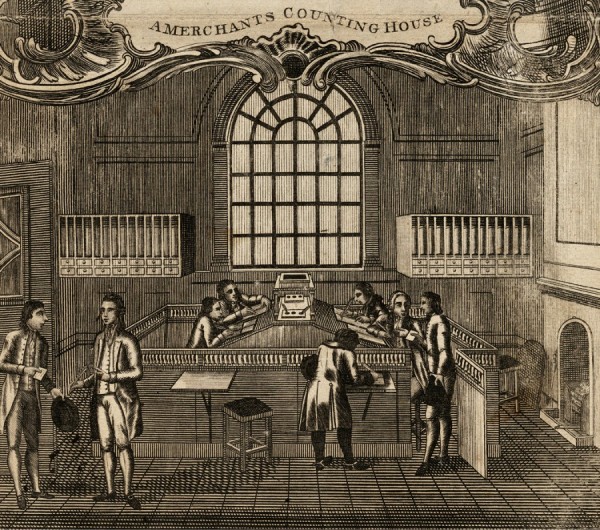
Detail of A Merchant’s Counting House, Philadelphia, Pennsylvania, ca. 1790–1800. Engraved by Alexander Lawson (1773–1846), published by T. Dobson, PR 031. (Courtesy, Bella C. Landauer Collection of Business and Advertising Ephemera, New-York Historical Society, 98124d.) A desk with a double-sided slant top accommodates four clerks within a gated enclosure. Small writing tables are attached to the gated wall, and two large cases on the back wall hold account books. [New-York Historical Society is now known as New York Historical.]

Ralph Earl (1751–1801), Portrait of Elijah Boardman (1760–1846), New Milford, Connecticut, 1789. Oil on canvas. H. 83", W. 51". (Copyright © The Metropolitan Museum of Art, bequest of Susan W. Tyler, 1979, acc. 1979.395; Art Resource, New York.) Boardman was a dry goods merchant in Connecticut. Green baize covers the slanted writing surface of his tall bookcase-desk.
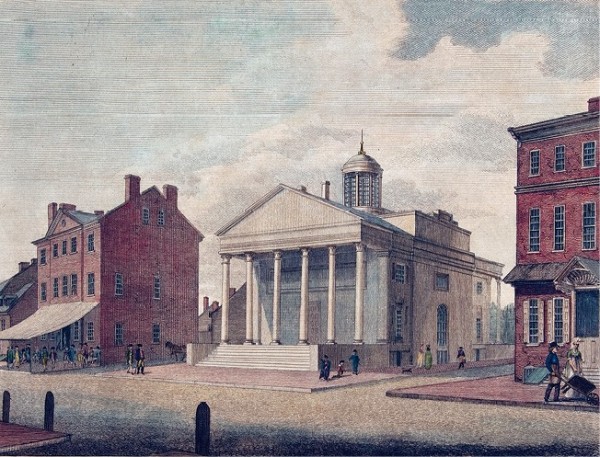
Bank of Pennsylvania, South Second Street, Philadelphia, drawn, engraved, and colored by William Russell Birch and Thomas Birch, published in Birch’s Views of Philadelphia, plate 27. (Courtesy, Winterthur Library, Printed Book and Periodical Collection.) The bank was designed by Benjamin Henry Latrobe (1764–1820) in the new Greek Revival style and built between 1798 and 1801. The building to the left with the front awning is City Tavern which, like the Tontine Coffee House in New York, served as a merchant’s exchange.

Lewis Miller, Interior of York Bank, York, Pennsylvania, 1812. Ink and watercolor drawing and text on paper. (Courtesy, York County History Center, York, Pa.) Pictured are John Schmitd [sic], cashier, and the Reverend Daniel Dunn, patron.
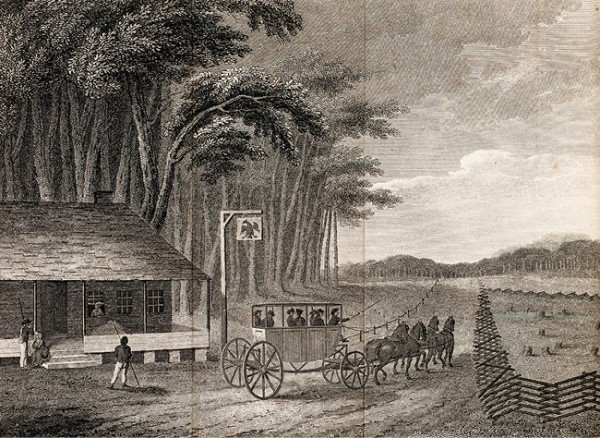
American Stage Waggon, drawn by Isaac Weld, engraved by James Storer, published by I. Stockdale, London, 1798. Illustrated in Isaac Weld, Travels through the States of North America and the Provinces of Upper Canada and Lower Canada . . . 1795, 1796, and 1797, 2 vols. (London: John Stockdale, 1800), 1: frontispiece. (Courtesy, Winterthur Library, Printed Book and Periodical Collection.)
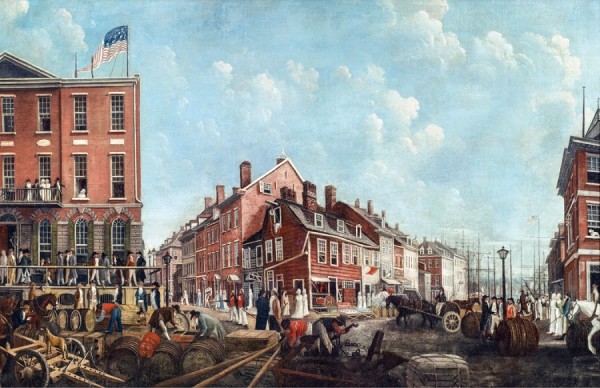
Francis Guy (1760–1820), The Tontine Coffee House, New York, New York, ca. 1797. Oil on linen. H. 43", W. 65". (Purchase, the Louis Durr Fund, New-York Historical Society, acc. 1907.32.) The Coffee House was located at the intersection of Wall and Water Streets adjacent to the East River.
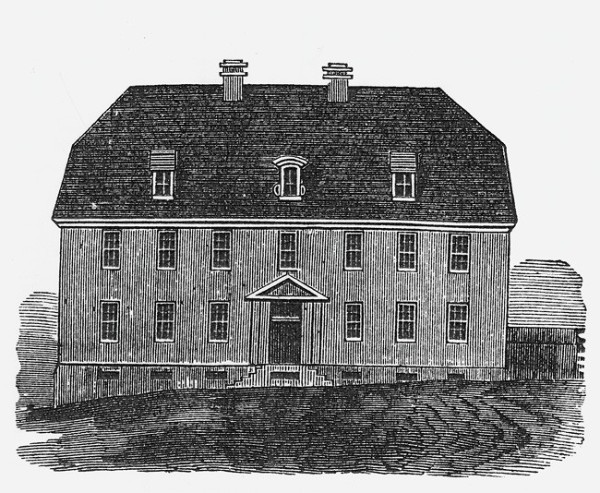
The Sun Inn, Bethlehem, Pennsylvania, in William C. Reichel, The Old Sun Inn at Bethlehem, Pa., 1758 (Doylestown, Pa.: W. W. H. Davis, 1876), frontispiece. (Courtesy, Moravian Archives, Bethlehem, Pennsylvania; photo, Winterthur Museum.)
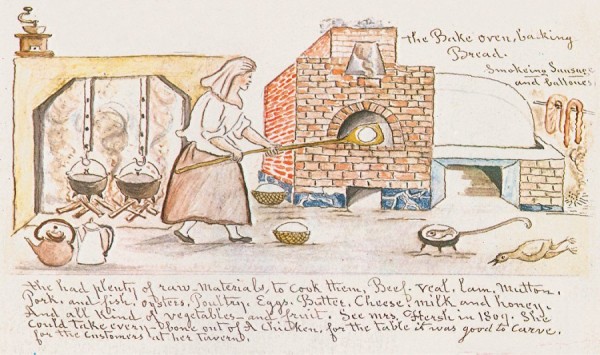
Lewis Miller, Mrs. Hersh’s Tavern, York, Pennsylvania, 1809. Ink and watercolor drawing and text on paper. (Courtesy, York County History Center, York, Pa.) Pictured is a kitchen in a hostelry of German-American background. Food is being prepared in large kettles, long-handled frying skillets, and a bake oven, where the cook-proprietor is using a long-handled wooden peel to insert a loaf of bread for baking after the dough has risen in its cloth-covered basket like those in the middle ground.
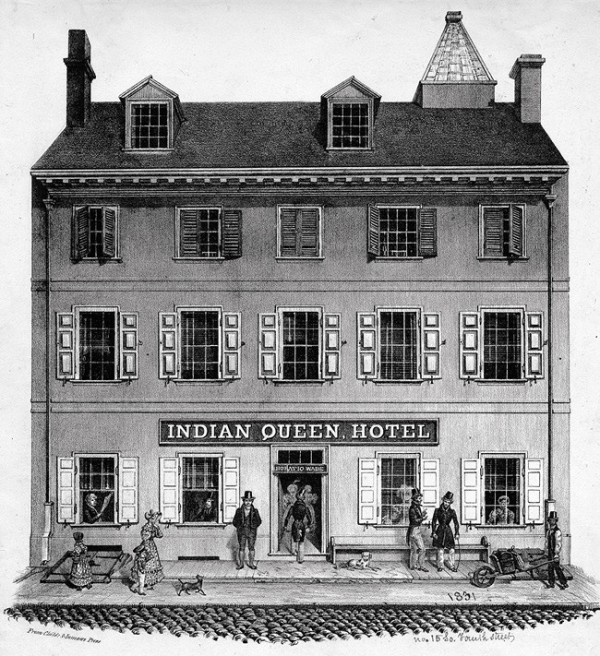
Indian Queen Hotel, Philadelphia, ca. 1831. Lithograph printed by Childs and Inman. H. 12 3/8", W. 11 1/2". (Courtesy, The Library Company of Philadelphia.) Several decades after the visit of Francisco de Miranda to Philadelphia, the Indian Queen Inn became a hotel at the same location, Fourth and Chestnut Streets.
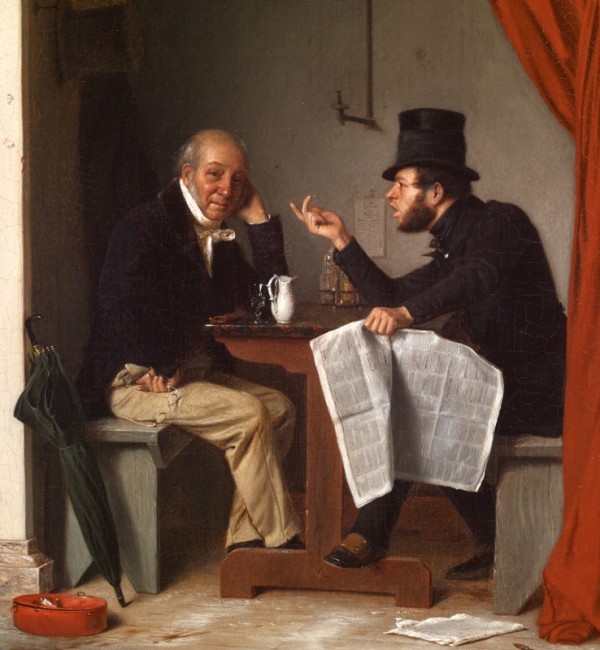
Richard Caton Woodville (1825–1856), Politics in an Oyster House, painted in Düsseldorf for a Baltimore patron, 1848. Oil on canvas. H. 16", W. 13". (Courtesy, The Walters Art Museum, Baltimore.) The setting here closely matches the description of the three-sided booths in the Golden Tun Tavern, Philadelphia, each booth also furnished with two benches and a table and a curtain on a rod at the front that could be drawn for privacy. The lighting fixture is an intrusion of the later period of the canvas.
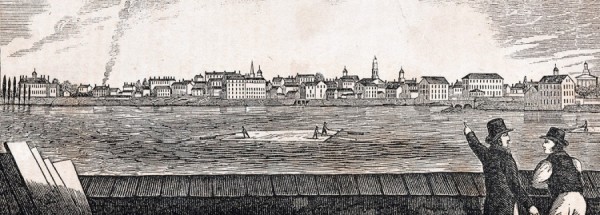
South View of Trenton, N.J., in John Warner Barber and Henry Howe, Historical Collections of the State of New Jersey (Newark, N.J.: Benjamin Olds, 1844), facing p. 280. (Courtesy, Winterthur Library, Printed Book and Periodical Collection.) The two rafts of timber manned by helmsmen on the Delaware River probably are destined for a Philadelphia market.
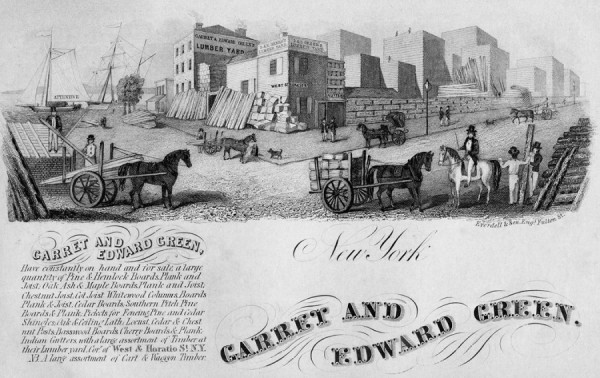
Handbill, Garrett and Edward Green, New York, New York, ca. 1845. Engraved by Everdell and Son. H. 5 1/4", W. 8 3/8". The mammoth size of this facility speaks to the rapid expansion of the city before the mid-nineteenth century.
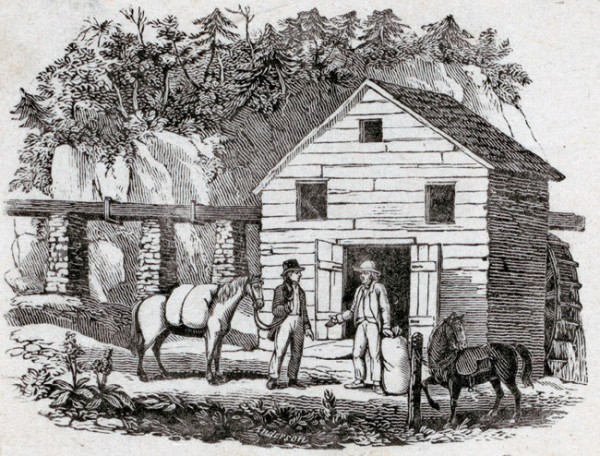
Alexander Anderson (1775–1870), [A Rural Gristmill], northeastern United States, ca. 1825–1850. Wood engraving. (Courtesy, The Miriam and Ira D. Wallach Division of Art, Prints, and Photographs: Print Collection, “Scenes of daily life in nineteenth-century America,” The New York Public Library Digital Collections, 1794–1870.) The power source for the gristmill is just visible behind the building: a large vertical overshot waterwheel placed in motion by water carried to it in an elevated millrace from the water source.
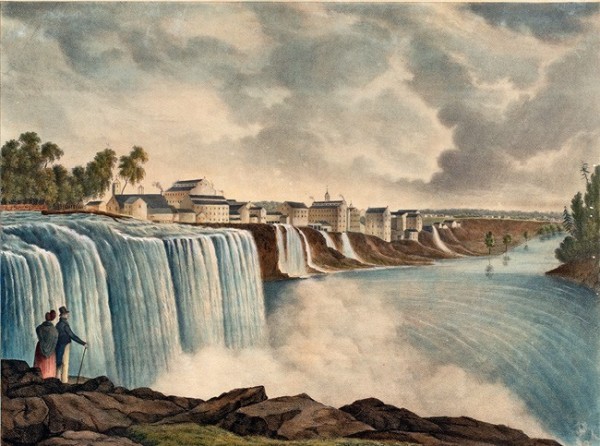
The Upper Falls of the Genesee River at Rochester, N. Y., from the East Bank Looking N.W., Rochester, New York, 1835. Drawn by J. Young, lithographed by J. H. Bufford, published by C. and M. Morse, PR 020. (Courtesy, Collection of Geographic Images, New-York Historical Society, 98180d.) From a small village established at the start of the nineteenth century, Rochester increased rapidly in area and population after 1825 following the opening of the Erie Canal. Wheat, already being grown in the Genesee Valley, quickly became a leading crop when the power of the falls of the Genesee River was harnessed. That power supported the vastflour milling complex shown here, among other businesses. [New-York Historical Society is now known as New York Historical.]
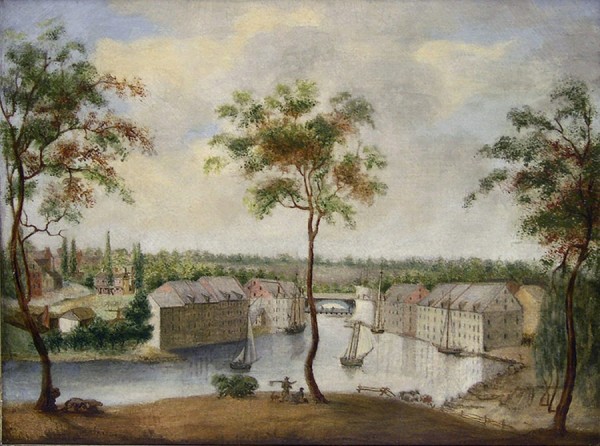
Bass Otis (1784–1861), Brandywine Mills, Wilmington, Delaware, ca. 1840. Oil on canvas. H. 31 1/4", W. 40 3/8" (framed). (Courtesy, Delaware Historical Society, gift of H. Fletcher Brown, 1941.051.)
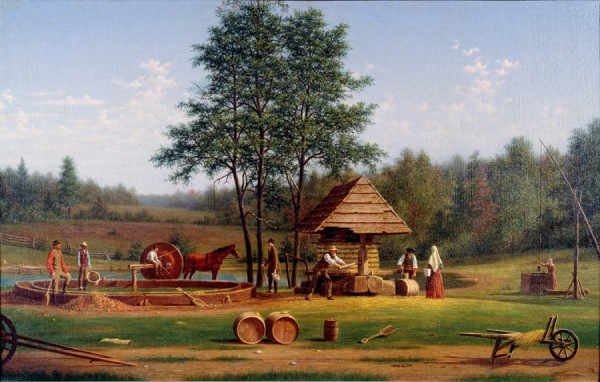
William Moore Davis (1829–1920), Cider-Making on Long Island, ca. 1865–1875. Oil on canvas. H. 19 3/4", W. 29 3/4". (Courtesy, Fennimore Art Museum, Cooperstown, New York, gift of Stephen C. Clark, acc. 368.1955; photo, Richard Walker.)
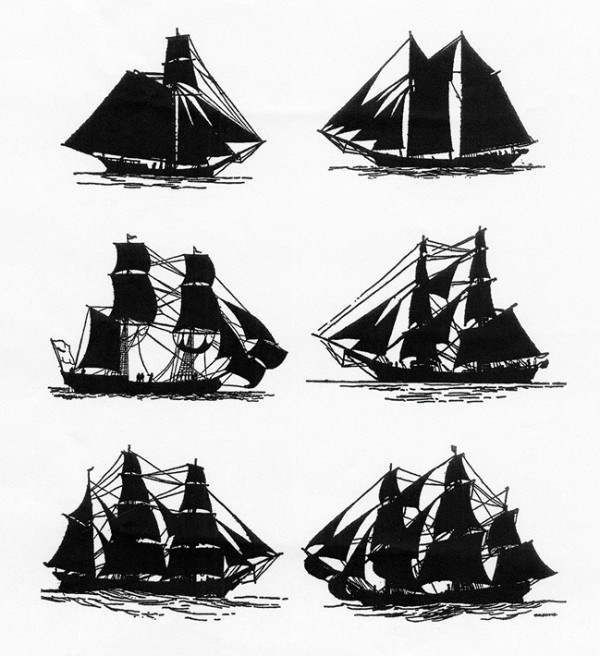
Principal types of American sailing vessels, 1760–1840. Composite from Charles G. Davis, Shipping and Craft in Silhouette (Salem, Mass.: Marine Research Society, 1929), figs. 8, 17, 23, 28, 51. (Courtesy, Peabody Essex Museum.) The distinctive shape, number, and arrangement of sails and masts differentiate types of vessels without reference to the hull.
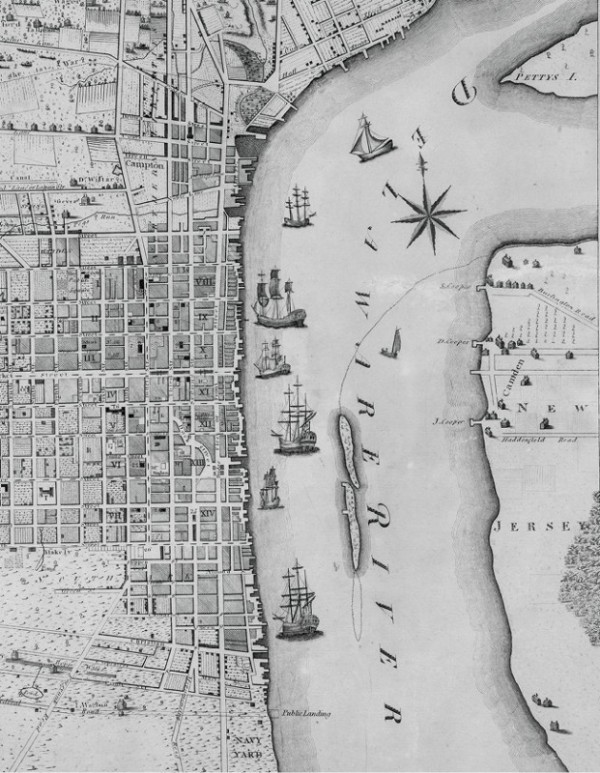
Detail of a Plan of the City of Philadelphia and Its Environs, Pierre Charles Varlé, cartographer, Robert Scot, engraver, Philadelphia, Pennsylvania, 1802. Line etching on laid paper (state two). Overall H. 20 1/2", W. 27". (Courtesy, Winterthur Museum, acc. 1960.0358.001 A.) The city’s many shipping wharves along the Delaware River, including parts of the Northern Liberties and Southwark, speak to the flourishing state of Philadelphia when it served as the national capital from 1790 to 1800.
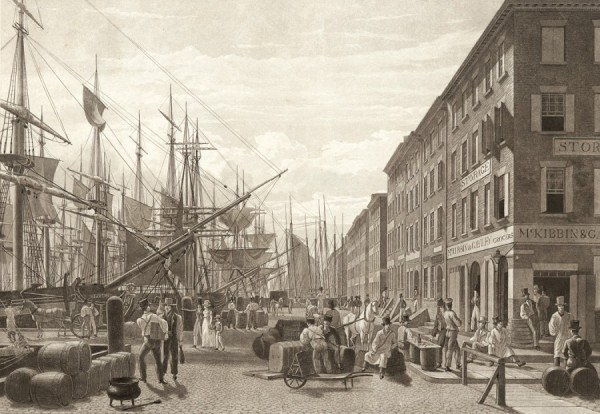
South St. from Maiden Lane, New York, New York, ca. 1834. Aquatint drawn and etched by William J. Bennett (1787–1844) after the engraver’s painting, published by Henry J. Megarey. (Courtesy, The Miriam and Ira D. Wallach Division of Art, Prints, and Photographs: The I. N. Phelps Stokes Collection of American Historical Prints, The New York Public Library Digital Collections.) The site on South Street is on the East River looking south from Maiden Lane, where two blocks farther along the waterfront the observer could view the Tontine Coffee House a short distance up Wall Street and perceive the full impact of America’s leading business center.
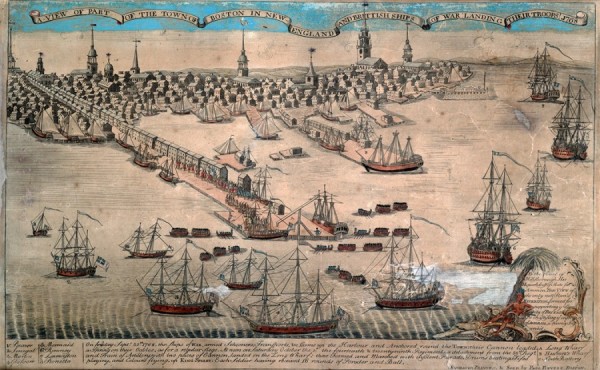
A View of Part of the Town of Boston in New-England and Brittish [sic] Ships of War Landing Their Troops!, Boston, 1770. Line engraving by Paul Revere (1735–1818). H. 8 5/8", W. 15 3/8". (Courtesy, Boston Athenaeum, George Francis Parkman Fund purchase, 1955, acc. 1955.2.) A sizeable row of storehouses stood on Long Wharf from before the Revolution.
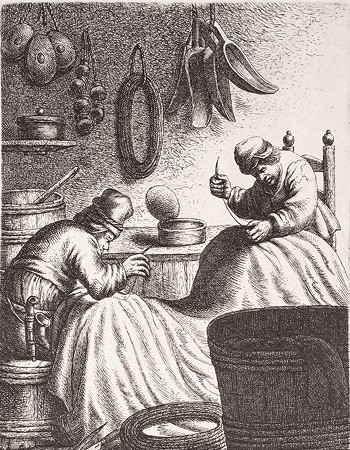
Sailmakers, in Jan Joris van der Vliet, [Book of Crafts and Trades] (Holland, 1635; reprinted in Harry Bober, Jan Van Vliet’s Book of Crafts and Trades [Albany, N.Y.: Early American Industries Association, 1981])), pl. 11. (Photo, Winterthur Library.) Although this is an early representation of the craft of sail making, craft procedure was not significantly changed by use of a sailmaker’s bench for seating and easy access to the tools of the trade.
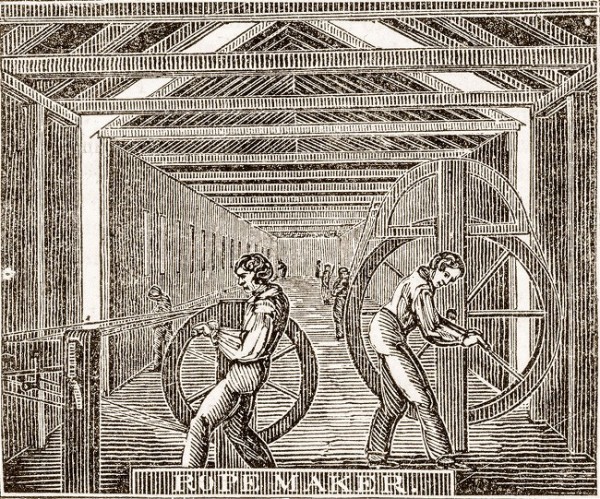
Facility of the Rope Maker, in Edward Hazen, The Panorama of Professions and Trades (Philadelphia: U. Hunt, 1839), p. 56. (Courtesy, Winterthur Library, Printed Book and Periodical Collection.)
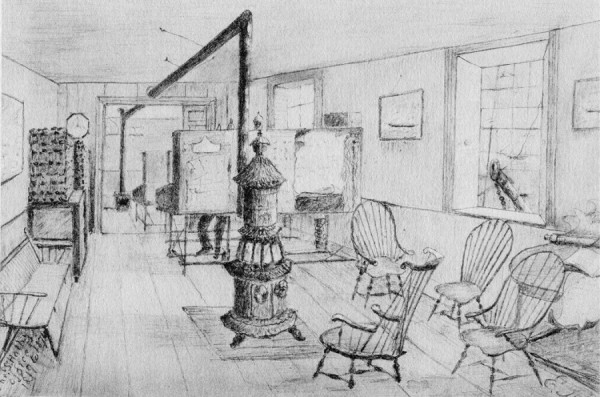
Office of Humphrey Hathaway, at the Head of Rotch’s Wharf, New Bedford, Massachusetts, ca. 1873, depicting a scene of 1819 or later. Pencil sketch on paper by Edward S. Russell. From Horatio Hathaway, A New Bedford Merchant (Boston: Merrymount Press, 1930). (Courtesy, New Bedford Whaling Museum, Estate of Thomas S. Hathaway.) This counting room adjacent to the wharves probably was typical of a moderate to large coastal facility of the early nineteenth century. The two long desks with their bookcases and slanted writing surfaces could accommodate two or three clerks each. By the late eighteenth century iron stoves had replaced the hearth as the heat source. Here, the forward area of the room with its Windsor seating, maps, and a telescope provided a convenient place for sea captains, clients, and others to meet and acquire news about markets, shipping conditions, and related subjects.
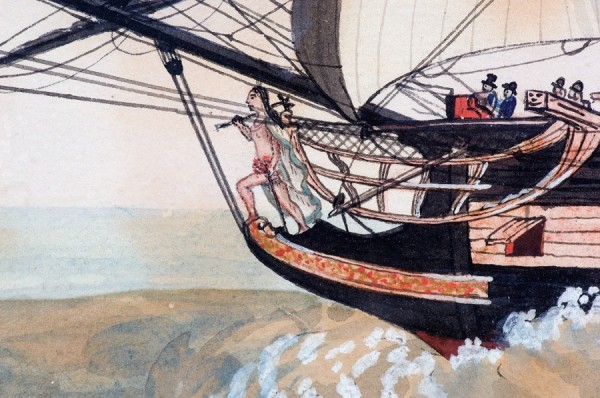
Joseph Howard (1780–1857), detail of bow of the frigate U.S.S. Essex, Salem, Massachusetts, after 1799. Gouache and watercolor on paper. Overall H. 19 3/4", W. 27 3/4". (Courtesy, Peabody Essex Museum, gift of John P. Howard, 1888, acc. M167.) Displayed in this detail are several carved and painted features that customarily were part of the overall design of a large vessel: a figurehead, here in the unusual form of a Native American, and whose left leg is bent at the knee in a “walking attitude”; a trail board, one of a pair, mounted on the sides of a vessel below the figurehead and extending the full or partial length of the vessel; a catface, a whimsical depiction of the facial features of a wild cat on either blunt end of a cathead.
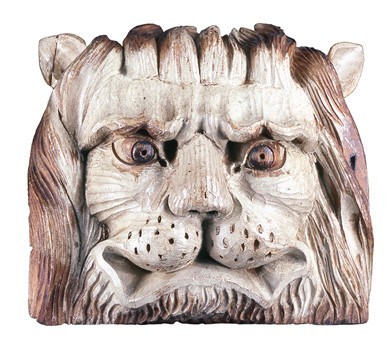
John H. Bellamy (1836–1914), carved lion’s head made as a catface for one end of a cathead, Portsmouth, New Hampshire, 1859. Pine. H. 13", W. 14". (Courtesy, Old Sturbridge Village.) A note pasted on the back of the image reads: “This piece was carved by John H. Bellamy, at 77 Daniel Street, January 1859.”
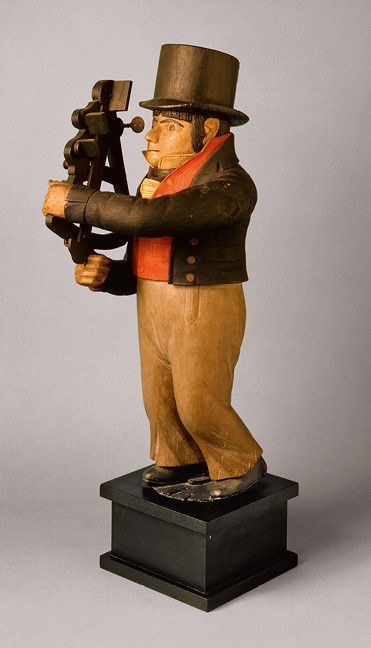
Samuel King (1749–1820), Little Navigator, Newport, Rhode Island, ca. 1810. Carved and polychromed wood shop sign. H. 24". The sign hung over the shop door of James Fales, nautical instrument maker of Newport and later over the shop of James Fales Jr. of New Bedford, Massachusetts, ca. 1830–1880. (Courtesy, New Bedford Whaling Museum.)
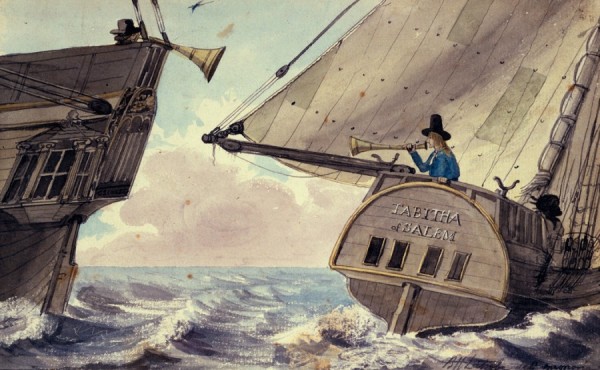
Benjamin Henry Latrobe (1764–1820), A Conversation at Sea, Virginia or Philadelphia, March 10, 1797. Watercolor on paper. (Courtesy, Maryland Center for History and Culture.) When two vessels met at sea, the use of speaking trumpets permitted the exchange of news and information.

Ship Montesquieu off the Harbor of Macao, anonymous, Philadelphia, 1812. Oil on canvas mounted on wood. H. 20 3/4", W. 27". (Courtesy, Girard College History Collections, Philadelphia, Pa., acc. 0063.) This ship was one of a variety of vessels owned by Stephen Girard (1755–1831); the figurehead of the ship was carved by William Rush (1756–1833).
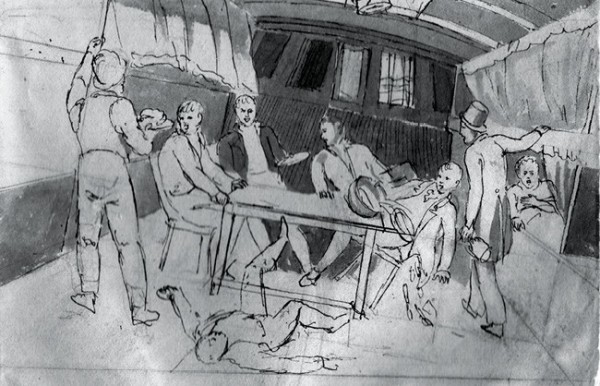
John Lewis Krimmel (1786–1821), Cabin of a Sailing Vessel, Philadelphia, Pennsylvania, 1812–1813. Ink, ink wash, and pencil on paper. H. 4 3/8", W. 6 1/4". From Krimmel, Sketchbook 2, 1812–1813, p. 11. (Courtesy, Winterthur Library, Joseph Downs Collection of Manuscripts and Printed Ephemera.) The water through which the vessel is sailing has become rough, and it is playing havoc with activity in the cabin.
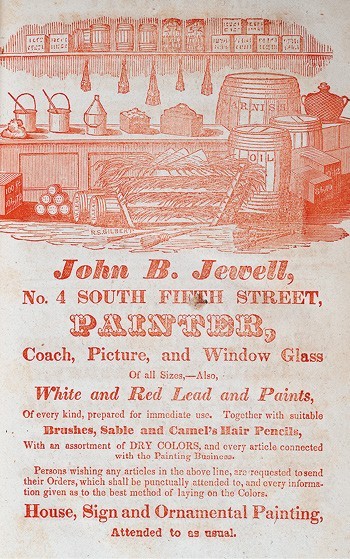
John B. Jewel, advertisement. From Desilver’s Philadelphia Directory and Stranger’s Guide for 1837 (Philadelphia: Robert Desilver, 1837), n.p. (Courtesy, Winterthur Library, Printed Book and Periodical Collection.)
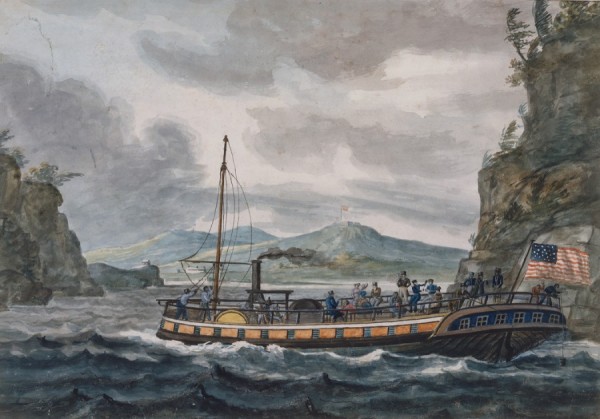
John Lewis Krimmel, Steamboat Travel on the Hudson River, Philadelphia, Pennsylvania, 1812–13. Watercolor and gouache on white wove paper. H. 10", W. 14 1/2". (Courtesy, Metropolitan Museum of Art, Rogers Fund, 1942, acc. 42.95.7; Art Resource, New York.) While traveling in America from 1811 to 1813, Paul Petrovich Svinin (1787/88–1839) assembled a portfolio of 52 watercolor views of North America, some purchased from Krimmel, including this view of an early steamboat. Carried back to Russia, the portfolio eventually came into the possession of an American following the tumult of the Russian Revolution. By 1930 the portfolio was in the possession of R. T. Haines Halsey, from whom in time it was transferred to the Metropolitan Museum of Art, where Halsey was founder of the American Wing. See also Anneliese Harding, John Lewis Krimmel: Genre Artist of the Early Republic (Winterthur, Del.: Winterthur Publications, 1994), pp. 238–49.
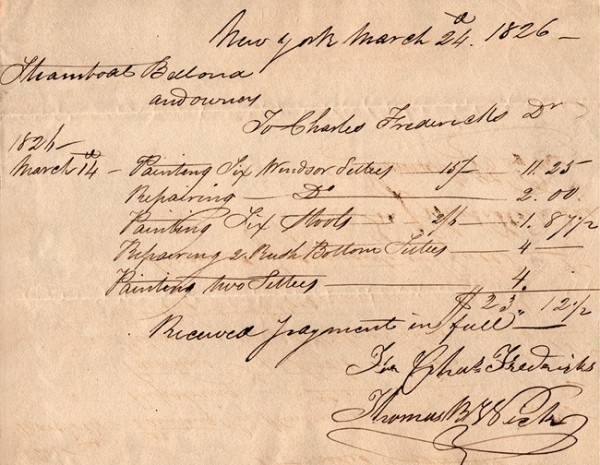
Charles Fredericks, bill to steamboat Bellona, New York, March 14, 1826. (Courtesy, Winterthur Library, Joseph Downs Collection of Manuscripts and Printed Ephemera.)
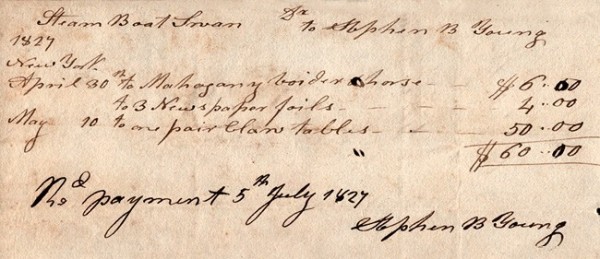
Stephen B. Young, bill to steamboat Swan, New York, April 30–May 10, 1827. (Courtesy, Winterthur Library, Joseph Downs Collection of Manuscripts and Printed Ephemera.)
